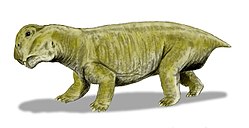| Cryptodontia Temporal range: Middle Permian - Late Permian | |
|---|---|
 | |
| Skull of Oudenodon latirostris | |
| Scientific classification | |
| Kingdom: | Animalia |
| Phylum: | Chordata |
| Clade: | Synapsida |
| Clade: | Therapsida |
| Clade: | † Anomodontia |
| Clade: | † Dicynodontia |
| Clade: | † Bidentalia |
| Clade: | † Cryptodontia Owen, 1860 |
| Subgroups | |
| |
| Synonyms | |
| |
Cryptodontia is a group of dicynodont therapsids that includes the families Geikiidae, Oudenodontidae, and Rhachiocephalidae. It was first named in 1860 by English paleontologist Richard Owen. Owen intended Cryptodontia to be a family, and the name was later changed to "Cryptodontidae" to reflect this ranking. The name Cryptodontia was restored in 2009 when it was redefined as a larger clade containing several families of dicynodonts. [1]





